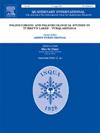Paleoenvironmental characterisation of the Campos Basin slope (SE Brazil) in front of Cape São Tomé based on benthic foraminiferal biofacies succession since MIS 5
IF 1.9
3区 地球科学
Q3 GEOGRAPHY, PHYSICAL
引用次数: 0
Abstract
The distribution of benthic foraminifera and the assemblage dynamics were analysed on piston core GL-54 to understand the changes in paleoecology since Marine Isotopic Stage 5 (MIS 5). The core was drilled on the upper slope of the Campos Basin on the Rio de Janeiro (Brazil) coast. Benthic foraminifera biofacies, ecological indices, lithological facies, biostratigraphy, and isotopic analyses were undertaken to characterise the paleoenvironment in front of Cape of São Tomé. Two distinct biofacies were identified in the GL-54 sedimentary record since the Last Interglacial Period (MIS 5). These two biofacies point to seasonal organic matter and a well-oxygenated environment, however, Biofacies 2 can be differentiated from Biofacies 1 by the presence of significant bottom water currents. Biofacies 2 has the same species as Biofacies 1, except for Miliolinella subrotunda. Benthic foraminiferal species and biofacies from GL-54 were compared to the ones present in the upper portion of the GL-39 piston core, which was drilled from the middle slope of the same basin. Species such as Globocassidulina crassa, Islandiella norcrossi, Alabaminella weddellensis, Bolivina paula, M. subrotunda, Bulimina aculeata, Globocassidulina subglobosa, Rotorbinella lepida, and Uvigerina peregrina were found in both piston cores. The biofacies of both piston cores were correlated, pointing to similarities between the upper slope and the middle slope in the Campos Basin since MIS 5. In general, the upper and middle slopes of the Campos Basin are characterised as a well-oxygenated environment with variation in the deposition of organic matter. In addition to these environmental factors, there is evidence for a strong bottom current in MIS 2 at both sites, probably due to the displacement of Brazil Current and Intermediate Western Boundary Current.
根据自 MIS 5 以来底栖有孔虫生物构成的演替,描述圣多美角前方坎波斯盆地斜坡(巴西东南部)的古环境特征
对活塞岩芯 GL-54 进行了底栖有孔虫分布和组合动态分析,以了解海洋同位素阶段 5(MIS 5)以来古生态的变化。该岩心是在巴西里约热内卢海岸坎波斯盆地上坡钻取的。通过底栖有孔虫生物构成、生态指数、岩相、生物地层学和同位素分析,确定了圣多美角前古环境的特征。自末次间冰期(MIS 5)以来,在 GL-54 沉积记录中发现了两种不同的生物面貌。这两种生物阶系表明存在季节性有机物和高氧环境,但生物阶系 2 与生物阶系 1 的区别在于存在大量底层水流。生物阶 2 中的物种与生物阶 1 相同,但不包括 Miliolinella subrotunda。将 GL-54 中的底栖有孔虫物种和生物阶系与从同一盆地中坡钻取的 GL-39 活塞岩芯上部的物种和生物阶系进行了比较。在两个活塞岩芯中都发现了 Globocassidulina crassa、Islandiella norcrossi、Alabaminella weddellensis、Bolivina paula、M. subrotunda、Bulimina aculeata、Globocassidulina subglobosa、Rotorbinella lepida 和 Uvigerina peregrina 等物种。两个活塞岩心的生物成因具有相关性,这表明自 MIS 5 以来,坎波斯盆地的上坡和中坡具有相似性。一般来说,坎波斯盆地的上坡和中坡是一个氧气充足的环境,有机物质的沉积情况各不相同。除这些环境因素外,有证据表明,在 MIS 2 期,这两个地点都出现了强大的底流,这可能是由于巴西洋流和中西边界洋流的位移造成的。
本文章由计算机程序翻译,如有差异,请以英文原文为准。
求助全文
约1分钟内获得全文
求助全文
来源期刊

Quaternary International
地学-地球科学综合
CiteScore
5.60
自引率
4.50%
发文量
336
审稿时长
3 months
期刊介绍:
Quaternary International is the official journal of the International Union for Quaternary Research. The objectives are to publish a high quality scientific journal under the auspices of the premier Quaternary association that reflects the interdisciplinary nature of INQUA and records recent advances in Quaternary science that appeal to a wide audience.
This series will encompass all the full spectrum of the physical and natural sciences that are commonly employed in solving Quaternary problems. The policy is to publish peer refereed collected research papers from symposia, workshops and meetings sponsored by INQUA. In addition, other organizations may request publication of their collected works pertaining to the Quaternary.
 求助内容:
求助内容: 应助结果提醒方式:
应助结果提醒方式:


